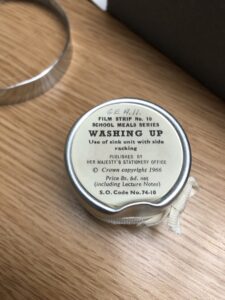 The Second World War saw a dramatic increase in communal dining, largely in response to food and fuel shortages. Cooking in bulk was cheaper and more efficient than cooking for individual households, while the 1944 Education Act meant that local authorities were obliged to offer a free lunchtime meal to school children. This ensured that the number of children receiving school meals grew from 250,000 children before the war, to an incredible 1.85 million children by 1945. To meet this demand, the British government was suddenly tasked with training enough dinner ladies to cater for all these school meals!
The Second World War saw a dramatic increase in communal dining, largely in response to food and fuel shortages. Cooking in bulk was cheaper and more efficient than cooking for individual households, while the 1944 Education Act meant that local authorities were obliged to offer a free lunchtime meal to school children. This ensured that the number of children receiving school meals grew from 250,000 children before the war, to an incredible 1.85 million children by 1945. To meet this demand, the British government was suddenly tasked with training enough dinner ladies to cater for all these school meals!
As part of this effort, in the early 1950s the Ministry of Education produced a series of film strips, on topics ranging from the use of an electric potato peeler to the correct way to wash the dishes. The National Library of Scotland holds a selection of these film strips, as part of a larger collection of government-issued film strips from the 1950s.
These film strips educated school dinner workers on personal and kitchen hygiene when mass-producing meals, trying to maximise efficiency while maintaining appropriate safety standards. For instance, one guide asked the instructors to “note the well-kept nails of the woman doing this work,” a nod to the importance of personal hygiene in the kitchen. Kitchens were designed to “save labour and movement” by arranging sinks and drying racks as efficiently as possible.
Another film strip, “Dining at School,” offers an insight into how novel school dining was in the early 1950s. Since many schools had not provided meals to such numbers before, the Ministry offered suggestions on how to lay out the furniture in a dining hall, depending on whether students would be eating in a school hall, in a prefabricated dining hall, in a hired hall, or in a classroom. In each scenario, the Ministry said that “circulation space” around tables and the service area should be the priority, to “ensure speedy service without danger of accident.” They also recommended that pupils ate in small, family-sized groups to create opportunities for “social training,” such as learning table manners.
Some of the other film strips provide an insight into the types of food that commonly appeared on the menu. For instance, separate instructional material was prepared for using an electric potato peeler, which could also be used for preparing other root vegetables such as carrots and parsnips.
The provision of school dinners is often something we take for granted, even though its cost and nutritional quality remain the subject of fierce political debate. It can, however, be easy to forget that the school dinner was not always a standard part of the school day. For millions of children, the 1940s and 1950s marked the point at which school dinners first became a part of everyday life, and these film strips provide a valuable insight into how the post-war government first sought to manage, and administer, this significant change.
Dr Sarah Thomson (Curator, Government and Civic Literacy, National Library of Scotland)